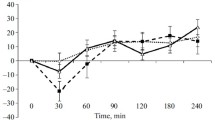Abstract
Morphine withdrawal was precipitated by injection of various morphine antagonists into restricted parts of the ventricular system or by microinjection of levallorphan into specific brain areas of rats made dependent on morphine by repeated pellet implantation. When the antagonists could spread only within the lateral ventricles and the 3rd ventricle, a weak withdrawal syndrome was induced; by antagonist administration into the restricted 4th ventricle, however, strong withdrawal signs like jumping were elicited even at small dosages. In microinjection experiments, structures in the midbrain and the lower brain stem proved to be the most sensitive to antagonist action. Although microinjections into thalamic nuclei also had some effect, it could not be excluded that the effects were due to uncontrolled spreading of the drug. This became especially clear from experiments with tritium-labeled levallorphan.
It is concluded that brain structures located in the anterior parts of the floor of the 4th ventricle and/or caudal parts of the periaqueductal gray matter are important sites of action for the development of physical dependence on morphine.
Similar content being viewed by others
References
Albus, K.: Method for application of drugs into separated parts of the cerebroventricular system. Physiol. Behav. 8, 569–571 (1971)
Akil, H., Mayer, D. J., Liebeskind, J. C.: Comparison chez le rat entre analgésie induite par stimulation de la substance grise péri-aquaeductale et l'analgésie morphinique. C. R. Acad. Sci. (Paris) 274, 3603–3605 (1972)
BlÄsig, J., Herz, A., Reinhold, K., ZieglgÄnsberger, S.: Development of physical dependence on morphine in respect to time and dosage and quantification of the precipitated withdrawal syndrome in rats. Psychopharmacologia (Berl.) 33, 19–38 (1973)
BlÄsig, J., Höllt, V., Herz, A., Paschelke, G.: Comparison of withdrawal precipitating properties of various morphine antagonists and partial agonists in relation to their stereospecific binding to brain homogenates. Psychopharmacologia (Berl.) 46, 41–51 (1976a)
BlÄsig, J., Papeschi, R., Gramsch, Chr., Herz, A.: Central serotonergic mechanisms and development of morphine dependence. Drug and Alcohol Dependence 1, No. 3, 221–232 (1976b)
Davson, H.: The cerebrospinal fluid. In: Handbook of neurochemistry, vol. II, A. Lajtha, ed., pp. 23–48. New York: Plenum Press 1969
Herz, A., Albus, K., Metys, T., Schubert, P., Teschemacher, Hj.: On the central sites for the antinociceptive action of morphine and fentanyl. Neuropharmacology 9, 539–551 (1970)
Herz, A., Teschemacher, Hj., Albus, K., ZieglgÄnsberger, S.: Morphine abstinence syndrome in rabbits precipitated by injection of morphine antagonists into the ventricular system and restricted parts of it. Psychopharmacologia (Berl.) 26, 219–235 (1972)
Himmelsbach, C. K.: With reference to physical dependence. Fed. Proc. 2, 201 (1943)
Kerr, F. W. L., Pozuelo, J.: Suppression of physical dependence and induction of hypersensitivity to morphine by stereotaxic hypothalamic lesions in addicted rats. Proc. Mayo Clin. 46, 653–665 (1971)
König, T. F., Klippel, R. A.: The rat brain: A stereotaxic atlas of the forebrain and lower parts of the brain stem. Baltimore: Williams and Williams 1963
Kuhar, M. J., Pert, C. B., Snyder, S.: Regional distribution of opiate receptor binding in monkey and human brain. Nature (Lond.) 245, 447–450 (1973)
Laschka, E., Herz, A., BlÄsig, J.: Sites of action of morphine involved in the development of physical dependence in rats. I. Comparison of precipitated morphine withdrawal after intraperitoneal and intraventricular injection of morphine antagonists. Psychopharmacologia (Berl.) 46, 133–139 (1976)
Pert, A., Yaksch, T.: Sites of morphine induced analgesia in the primate brain: Relation to pain pathways. Brain Res. 80, 135–140 (1974)
Simon, E.: Opiate receptors in human and animal brain. Proc. IXe C.I.N.P. Congr. Paris 1974. In: Neuropsychopharmacology, J. R. Boissier, H. Hippius, P. Pichot, eds., pp. 314–322. New York: American Elsevier Publ. Comp. 1975
Wei, E., Loh, H. H., Way, E. L.: Neuroanatomical correlates of morphine dependence. Science 177, 616–617 (1972)
Wikler, A., Norrell, H., Miller, D.: Limbic system and opioid addiction in the rat. Exp. Neurol. 34, 543–557 (1972)
Zeman, W., Innes, J. R. M.: Cragie's Neuroanatomy of the rat. New York-London: Academic Press 1963
Author information
Authors and Affiliations
Rights and permissions
About this article
Cite this article
Laschka, E., Teschemacher, H., Mehraein, P. et al. Sites of action of morphine involved in the development of physical dependence in rats. Psychopharmacologia 46, 141–147 (1976). https://doi.org/10.1007/BF00421383
Received:
Revised:
Issue Date:
DOI: https://doi.org/10.1007/BF00421383




